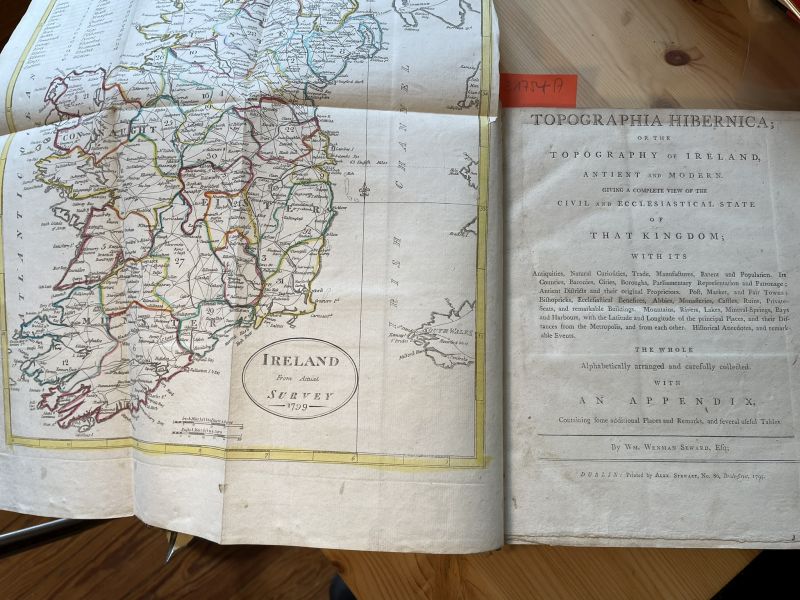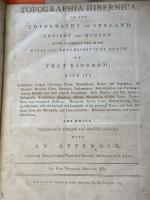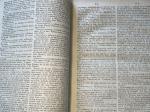Seward, Topographia Hibernica; Or the Topography of Ireland, Antient and Modern,
Topographia Hibernica; Or the Topography of Ireland, Antient and Modern, Giving a Complete View of the Civil and Ecclesiastical State of That Kingdom ; With Its Antiquities, Natural Curiosities, Trade, Manufactures, Extent and Population. Its Counties, Baronies, Cities, Boroughs, Parliamentary Representation and Patronage ; Antient Districts and their Original Proprietors. Post, Market, and Fair Towns ; Bishopricks, Ecclesiastical Benefices, Abbies, Monasteries, Castles, Ruins, Private-Seats and remarkable Buildings. Mountains, Rivers, Lakes, Mineral-Springs, Bays and Harbours with the Latitude and Longitude of the principal Places and their Distances from the Metropolis and from each other. Historical Anecdotes and remarkable Events. The whole alphabetically arranged and carefully collected. With an Appendix, containing some additional Places and Remarks and several useful Tables.
First Edition. Dublin, Printed by Alexander Stewart, 1795. Quarto. Frontispiece (Beautiful Handcoloured Fold-out-Map of Ireland), unpaginated with c.350 pages and Appendix. No Plates included in this Volume ! Original half-leather. Binding in poor condition. Interior a little dusty but very good. The Map in excellent condition.The Text clean.
Important Publication regarding the History of Place Names of irish Towns and villages, Tables with Distances between Ports and Towns, Circuit Roads of the Judges with “The Assize Towns printed in Italicks” (Munster Circuit, Connaught Circuit, Leinster Circuit, Circuit Ulster) /
Seward, William Wenman (d. 1805), attorney and writer, may have been born in Dublin. Little is known of his family or early life. In May 1776 he was admitted as an exchequer attorney at King’s Inns, Dublin, and from c.1782 he lived at Prussia St., conducting his legal practice from there. He later moved to 151 James’s St., where he lived briefly and shared premises with a Thomas Seward, perhaps his son or nephew, who was a solicitor in chancery. He died at this address in 1805, probably in December. During his lifetime he achieved some fame as a political and topographical writer. He was active on the fringes of the Volunteer movement in the 1780s, publishing The rights of the people asserted and the necessity of a more equal representation in parliament stated and proved (1783).
His more famous publications were, however, topographical writings. In 1789 he published his Hibernian Gazeteer: being a description of the several roads, market, post and fair towns in Ireland. This A–Z of Irish towns was an immediate success and provided not only useful information for the traveller but also a brief history of Ireland. Buoyed up with this success, he later wrote that ‘the general approbation with which the plan of the Hibernian Gazeteer was favoured by the public, induced the author to pursue it on a more extensive scale’ (Topographia Hibernica, introduction). In 1795 he published his Topographia Hibernica: or the topography of Ireland, antient and modern, giving a complete view of the civil and ecclesiastical state of that kingdom. A product of prodigious research and scholarship of considerable accuracy, it was well received. In an extended list of the towns of Ireland, Seward provided historical information on each place named and further appendices on the civil and church administration in Ireland. It was dedicated to the duke of Leinster (qv) and included some very fine illustrations of prominent historical monuments in Ireland and also a highly detailed map. Seward’s last major publication was Collectanea politica: or the political transactions of Ireland, 1760–1803 (3 vols, Dublin, 1801–4), an impartial and considered treatment of major political events of the late eighteenth century, dealing primarily with the growth of the Volunteer movement and the passing of the act of union.
Seward’s works have become both extremely rare and highly collectable. His Topographia Hibernica is especially sought after by collectors, largely due to the fine quality of the illustrations. The NLI has a heavily annotated copy that was originally in the collection of Dr Jaspar Robert Joly (qv), the noted bibliophile. Seward has sometimes been confused with the anecdotist William Seward (1747–99), FRS. (Source: Dictionary of Irish Biography)
- Keywords: Catalogue Irish History Two – Origins of Irish Identity · History of Place Names in Ireland · Irish History – Rare · Irish History in the 18th century · Irish History in the 19th century · Irish Placenames · Maps of Ireland · Place Names of Ireland · Placenames
- Inventory Number: 31754AB
EUR 750,--
© 2025 Inanna Rare Books Ltd. | Powered by HESCOM-Software














